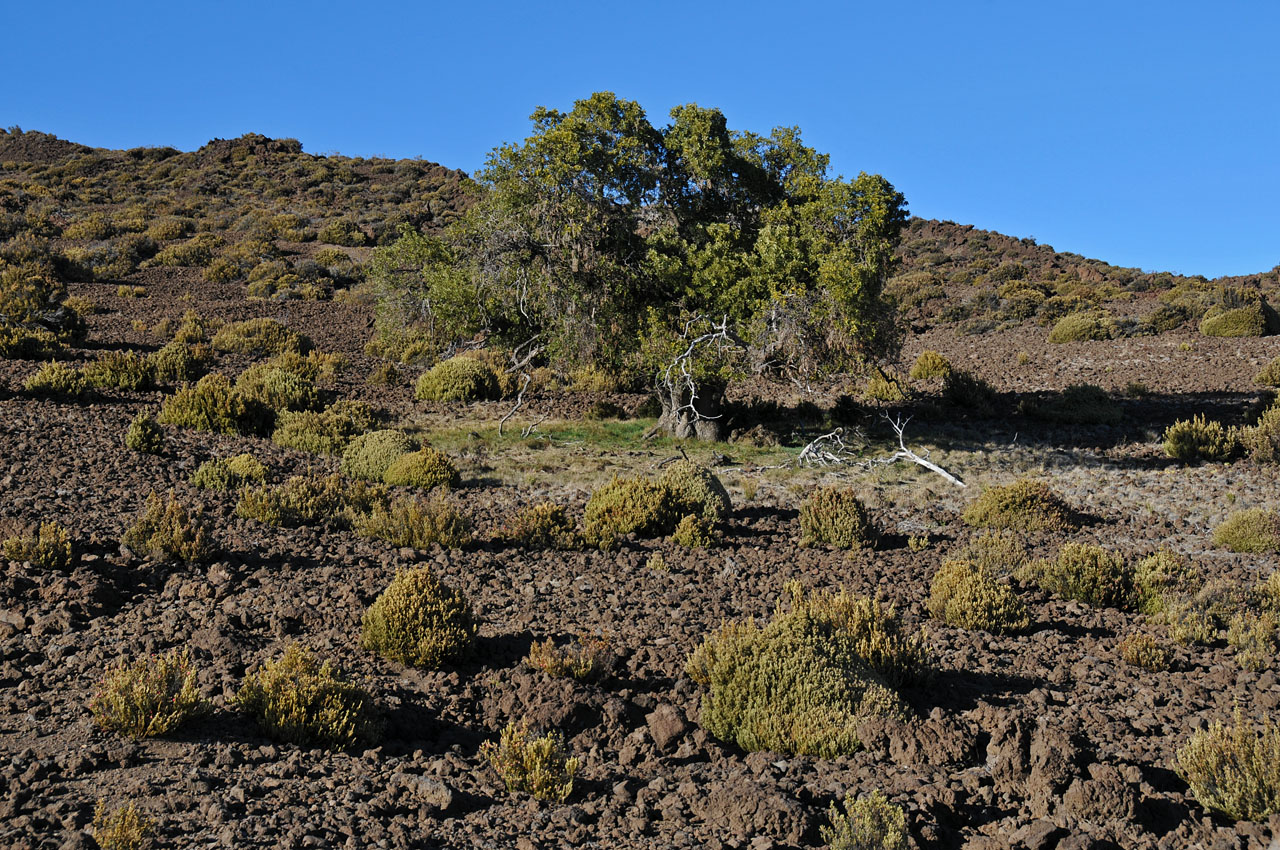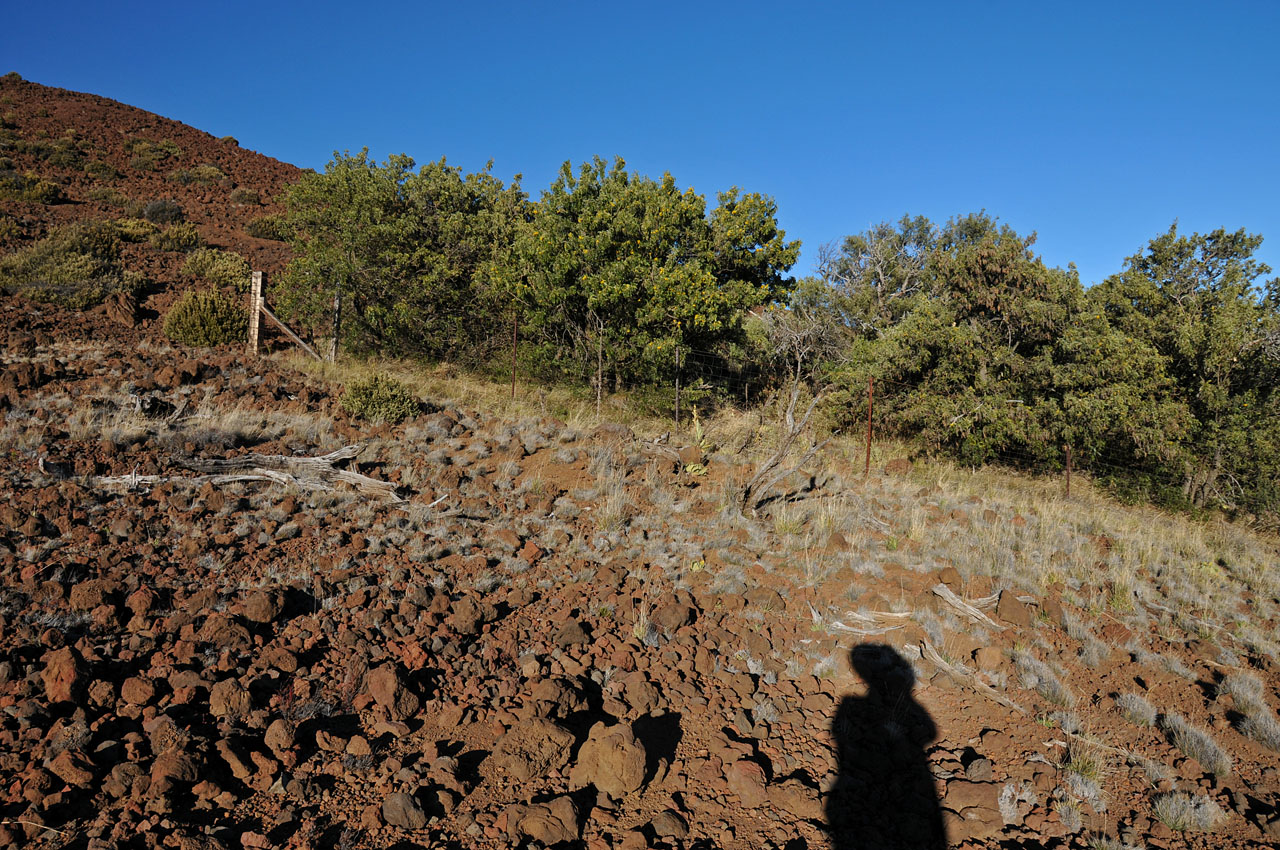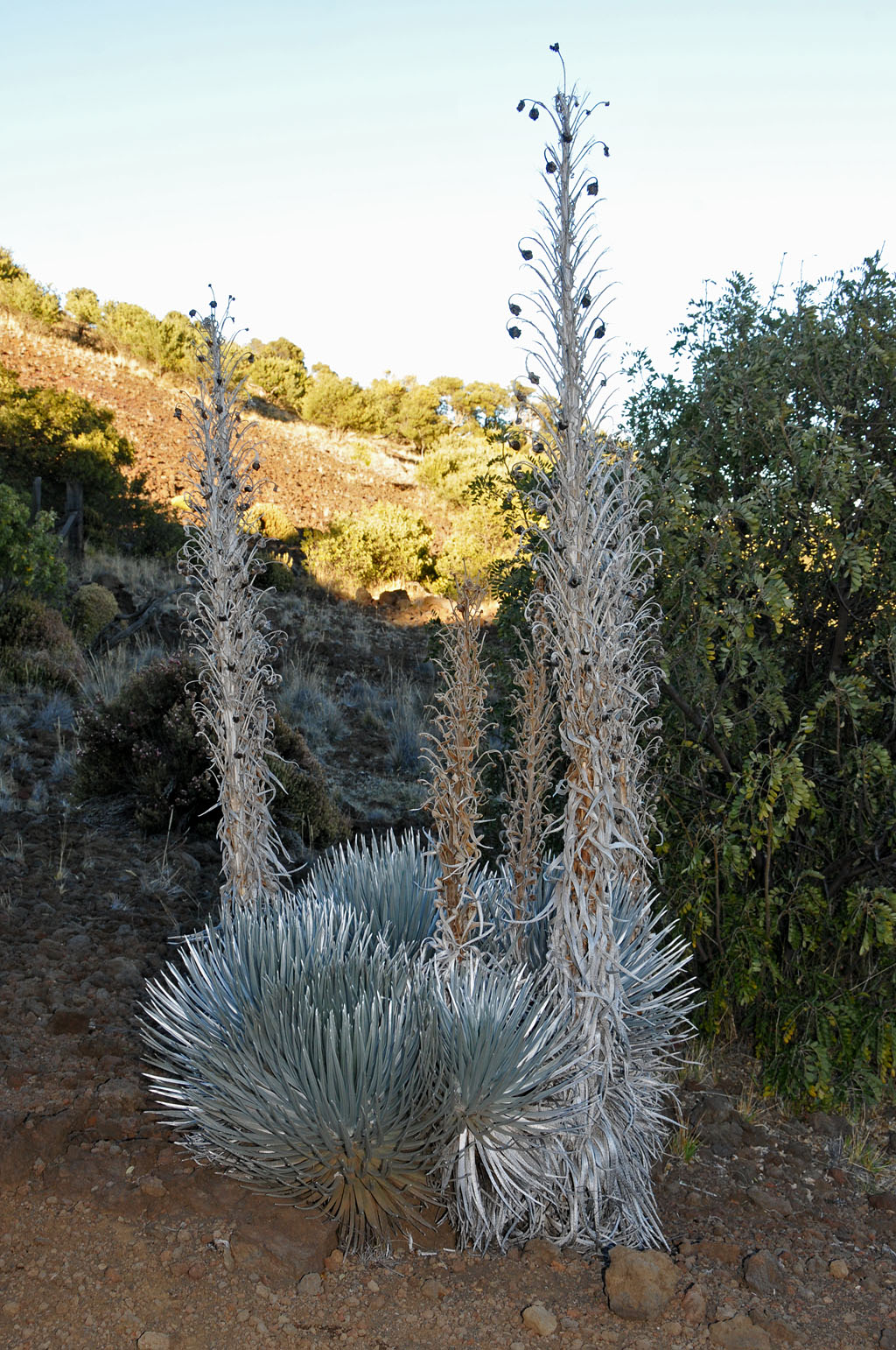Saturday's weather was rainy all over the windward side, so I ended up going all the way up to the Halepohaku area of Mauna Kea Forest Reserve to get above the clouds. Unfortunately it was very windy up there, but at least the weather was cool and stable.
I followed transect 109 up to Halepohaku and counted birds at several of the middle stations. There were predictably few birds due to the wind. On top were roughly equal numbers of 'amakihi and Japanese white-eye. There were occasional 'apapane and house finch. I also collected seeds from a rare dubautia arborea that I passed, and planted them up near Halepohaku where the young plants will be less likely to be eaten by pigs and sheep. (I'm wondering if the abundant game birds on Mauna Kea also eat the seeds?) I encountered a small group of pigs eating the chenopodium bushes (native lambsquarter).
After an e-mail break at HP I headed down the upper Mauna Kea ring road to find transect 110 for the first time. The road cuts through the middle of the transect, and I went up the transect collecting new coordinates for each station with my GPS. The wind died down a bit and I started counting birds again. With lower wind there were more 'amakihi and 'apapane, but fewer white-eye.
As expected, no palila anywhere. The mamane forest close to the Halepohaku complex (formerly hunting lodge) has been recovering for quite a while, but further from human activity the mamane forest was grazed more intensely for longer. Transect 110 has many venerable old trees with 5 foot high browse lines, and is littered with the skeletons of ancient dead trees. There was some mamane regeneration around stations 6-10, but much less around 1-5. The top of transect 110 is at the current treeline and scattered throughout the cinder field there are extremely picturesque mamane with strong browse lines and green grass underneath. Tree skeletons and lingering patches of lean grass tufts indicate the greater former coverage of the mamane forest.
After reaching the top of transect 110 I went over to look at the 1960's era Pu'u Kole sheep exclosure (nowhere near Pu'u Kole, BTW), where mamane regeneration in the absence of pigs, sheep and goats was studied to show whether the forest could recover on its own. The sheep exclosure is like an oasis in the cinder field, with a clump of big mature trees inside and only seedling trees outside. (QED) Below the lower edge of the exclosure is the much more recent silversword plantation, with plantings of various vintages scattered among the shrubs and boulders. The number of silverswords has increased a lot since I was last in the area 3 years ago.
After using every last minute of daylight I had to quickly march back down to my car. I got back to Halepohaku just as the last light of dusk faded away. By the time I reached my car at the bottom of transect 109 the "billions and billions" of stars shone brightly all around as if the tyrranical Sun never existed.
The highest mamane tree and the pukiawe-'ohelo shrubland above treeline:

Mature mamane trees sheltered inside the old Pu'u Kole sheep exclosure:

Mauna Kea Silversword:

I followed transect 109 up to Halepohaku and counted birds at several of the middle stations. There were predictably few birds due to the wind. On top were roughly equal numbers of 'amakihi and Japanese white-eye. There were occasional 'apapane and house finch. I also collected seeds from a rare dubautia arborea that I passed, and planted them up near Halepohaku where the young plants will be less likely to be eaten by pigs and sheep. (I'm wondering if the abundant game birds on Mauna Kea also eat the seeds?) I encountered a small group of pigs eating the chenopodium bushes (native lambsquarter).
After an e-mail break at HP I headed down the upper Mauna Kea ring road to find transect 110 for the first time. The road cuts through the middle of the transect, and I went up the transect collecting new coordinates for each station with my GPS. The wind died down a bit and I started counting birds again. With lower wind there were more 'amakihi and 'apapane, but fewer white-eye.
As expected, no palila anywhere. The mamane forest close to the Halepohaku complex (formerly hunting lodge) has been recovering for quite a while, but further from human activity the mamane forest was grazed more intensely for longer. Transect 110 has many venerable old trees with 5 foot high browse lines, and is littered with the skeletons of ancient dead trees. There was some mamane regeneration around stations 6-10, but much less around 1-5. The top of transect 110 is at the current treeline and scattered throughout the cinder field there are extremely picturesque mamane with strong browse lines and green grass underneath. Tree skeletons and lingering patches of lean grass tufts indicate the greater former coverage of the mamane forest.
After reaching the top of transect 110 I went over to look at the 1960's era Pu'u Kole sheep exclosure (nowhere near Pu'u Kole, BTW), where mamane regeneration in the absence of pigs, sheep and goats was studied to show whether the forest could recover on its own. The sheep exclosure is like an oasis in the cinder field, with a clump of big mature trees inside and only seedling trees outside. (QED) Below the lower edge of the exclosure is the much more recent silversword plantation, with plantings of various vintages scattered among the shrubs and boulders. The number of silverswords has increased a lot since I was last in the area 3 years ago.
After using every last minute of daylight I had to quickly march back down to my car. I got back to Halepohaku just as the last light of dusk faded away. By the time I reached my car at the bottom of transect 109 the "billions and billions" of stars shone brightly all around as if the tyrranical Sun never existed.
The highest mamane tree and the pukiawe-'ohelo shrubland above treeline:

Mature mamane trees sheltered inside the old Pu'u Kole sheep exclosure:

Mauna Kea Silversword:




